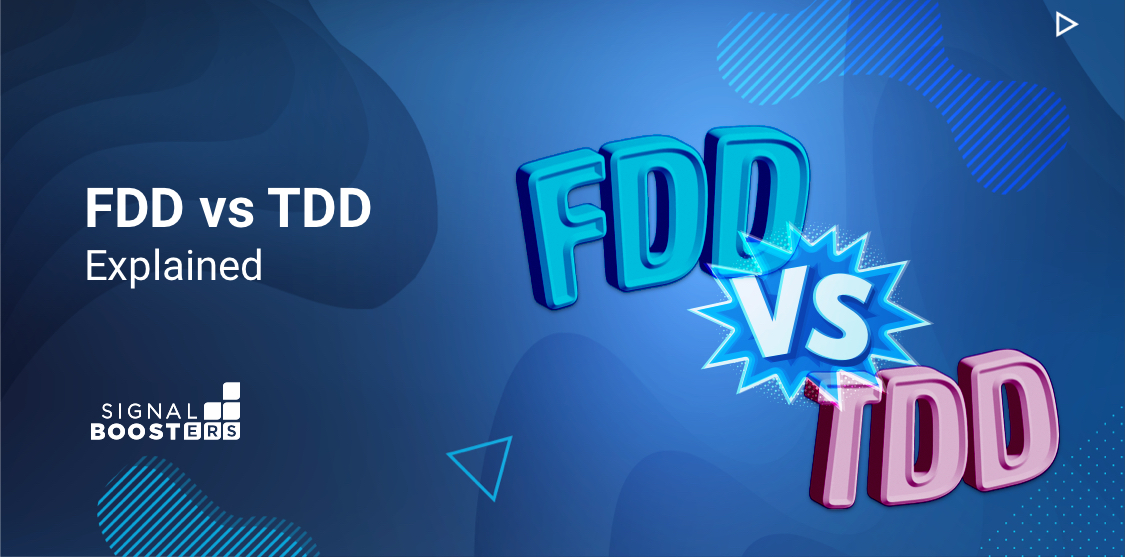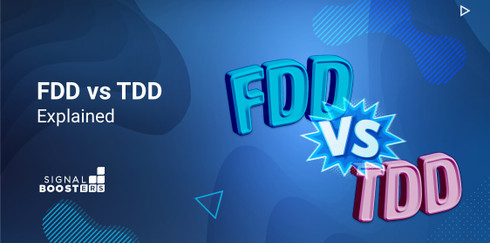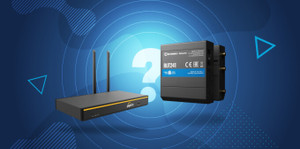FDD vs TDD Explained

You may have heard the terms FDD (Frequency Division Duplex) vs TDD (Time Division Duplex). These refer to different ways of sending and receiving information. Both use radio frequencies to do so, and both work with LTE and 5G. One, FDD, is more often used in modern cellular technologies for several reasons. Some cell phone signal boosters can make use of both TDD and FDD, like the Asia/Oceania exclusive Cel-Fi Go G41. What are the differences between them? Is one better than the other? Why does 5G need both technologies to work properly?
Take advantage of our system design and installation services. Learn more or call us for a free consultation: 1-800-969-8189.
What are TDD and FDD?
TDD stands for Time Division Duplex. It is a means of communication using one frequency to send and receive information. The packages are separated by a small amount of time. The user (your cell phone) and the base station (the cell tower) communicate on one channel or frequency with different time slots for both uplink and downlink transmissions.
FDD stands for Frequency Division Duplex. It is a means of communication that uses two frequencies to send and receive information. The packages are separated by a buffer or guard frequency.The user (your cell phone) and the base station (the cell tower) communicate on two channels or frequencies one for each uplink and downlink transmission. This is called a paired frequency.
Both are used in 5G and LTE cellular technology.
What is LTE?
LTE is a high-speed fourth generation 4G communication standard. It’s widely used all over the world in cellular communications. Although we have access to 5G now, LTE remains the most common, accessible network on the planet.
Both FDD and TDD are used in LTE. Together they allow fast transfer of multimedia services like voice and data between devices. Your phone or tablet uses this technology to connect to the internet and make voice calls.
Why Does 5G Need Both FDD and TDD?
Using both FDD and TDD for 5G means that carriers can use multiple frequencies at the same time. Because the main challenge with 5G currently is that the signal is either high band, which is fast, or low band which goes far. By combining both TDD (high band) and FDD (low band) you get a perfect situation where 5G signal goes far and is fast.
Together these two create a higher average speed for 5G users. Ericsson and Qualcomm ran a 5G test proving that by combining TDD and FDD they can reach speeds of up to 2.5 Gbps. The potential for lighting fast 5G signal widely available to anyone is incredibly exciting.
Not only is it fast, but by using both TDD and FDD a single user's bandwidth will also increase. 700 MHz of spectrum was allocated for 5G FDD millimeter wave use in the sub-7 GHz bands. Using TDD, up to 400 MHz of that can be used simultaneously on four 100-MHz channels.
| Feature | 5G FDD | 5G TDD |
| Application | FDD is used where uplink and downlink are symmetrical | TDD is used where uplink and downlink is asymmetrical. |
| Interference with neighboring Base Stations | Less | More |
| Deployment type | Best for rural and suburban areas. | Best for urban areas with low-power nodes. |
| Beamforming | Explicit Beamforming Only | Explicit Beamforming Only |
| Frequency bands | Low frequency bands below 10 GHz | High frequency bands above 10 GHz. |
| Channel response | Downlink and uplink uses different channels, so they can't match perfectly. | Using one channel means that downlink and uplink match perfectly, making it better for MIMO and beamforming. |
Pros and Cons of TDD
As TDD uses a single frequency to transfer information with a time gap in between, it's not as fast as FDD.
Pros
- Uses fewer resources to set up, like hardware
- Uses a much simpler equalizer algorithm
- More effective spectrum usage because there is only one
- Can support higher data rates
- Lower latency
- Good for rural and suburban areas
Cons
- Needs strict phase/time synchronization to avoid interference between uplink and downlink transmissions
- Slower than FDD at similar distances
- Needs more base stations
- More base stations mean higher deployment and operating costs
- Possibility of cross-slot interference
Pros and Cons of FDD
As FDD uses two separate frequencies simultaneously, it's faster than TDD, but leads to spectrum wastage.
Spectrum wastage is where certain frequencies aren't being used to transmit data. Because there are only so many frequencies available, to have any that are lying dormant is a waste. With FDD if one of the bands dedicated to either uplink or downlink is not being used, even for a nanosecond, that's spectrum wastage. The guard band that separates them is also technically dormant, so counts as spectrum wastage too.
Pros
- Proven voice traffic technology
- Symmetric traffic needs no guard time
- Faster speeds for similar distances compared to TDD
- Fewer base stations needed
- Lower operation and deployment costs
Cons
- Spectrum wastage due to guard band and dual frequencies
- Cannot be used where spectrums are unpaired
- Higher hardware costs
FDD and TDD differences:
| Feature | FDD | TDD |
| Communication Channels | FDD or Frequency Division Duplexing uses two separate communication channels. One for transmission or downlink, and one for reception or uplink. A guard band is needed to keep them apart and eliminate crossover. Both the uplink and the downlink frequencies need to be symmetrical. | TDD or Time Division Duplexing uses a single frequency for both uplink and downlink. It sends data in serial binary format. The amount of time used for either uplink or downlink can be variable. |
| Guard Band or Guard Period | FDD uses a guard band to separate the frequencies. The size of the guard band doesn't affect capacity. | TDD uses a guard period to separate uplink and downlink on one frequency. If the guard period is too big, it will affect capacity. If it is too small, it can cause clashes in communication. |
| Constant / Intermittent Transmission | FDD is a constant transmission with no gaps. | TDD is an intermittent transmission for both uplink and downlink. This is because one frequency is used. This can lead to poorer performance. |
| Paired Spectrum | FDD must have two paired spectrums with a big enough gap in between them to work. | TDD does not need a paired spectrum as both uplink and downlink communication use the same channel. |
| Hardware Cost | FDD needs a diplexer and/or two antennas to filter both uplink and downlink channels. These can be expensive. | TDD does not need a diplexer and can use only one antenna. This makes it cheaper to install. |
| Cross Slot Interference | FDD doesn't experience cross-slot interference. | In TDD, the base station needs to be synchronized with the uplink and downlink. Cross-slot interference is where two base stations interfere with each other by using the same channel. |
| Common Uses | Terrestrial Microwave, Terrestrial Millimeter, Most LTE cellular communication. | WiFi, Bluetooth,, 5GHz P2P and P2MP radio communication. |
What is Cross Slot Interference?
Cross-slot interference is where TDD base stations interfere with each other, slowing the network. This only happens in TDD as it uses simultaneous transmission. All TDD networks use the same bandwidth, but each tower has different time slots for uplink, downlink, and guard periods. This allows each base station to transmit without interfering with the one next to it.
Imagine a room full of people. Only one person is allowed to talk at a time, and each person has their allocated talking times. If two or more people overlap in time, then the conversation will be garbled.
Base stations usually have a stronger link between each other than between themselves and the User Equipment (UE). Cross-slot interference usually happens when a base station in uplink is interfered with by a neighboring base station in downlink. Because the base stations have a stronger connection when communicating with each other, this interference will affect network speeds much more than if the neighboring station was communicating with a UE.
TDD vs FDD Explained
Both FDD and TDD are used in 5G and LTE. Each has its advantages and disadvantages. FDD is older than TDD, less flexible, and more expensive. It's faster though, and can transmit both uplink and downlink at the same time, and needs fewer base stations.
TDD is mostly used for WiFi and Bluetooth but is being used more and more in general cellular. It's flexible, able to be used with MIMO and beamforming, and easier to implement.
Both FDD and TDD are needed for 5G to work across all frequencies. FDD is better for coverage, i.e. it can go further, and TDD is better for capacity.
| Characteristic | FDD | TDD |
| Spectrum range | High | Low |
| Complexity | High | Low, but needs exact timing |
| Cost | Higher | Lower |
| Latency | Little to none | Depends on range and timing |
| Range | Unlimited | Shorter. Depends on guard period |
| Uplink/Downlink symmetry | Usually equal | Asymmetrical as needed |
| Dynamic Bandwidth Possibility | None | Flexible |
| MIMO and Beamforming | Difficult | Easier |
If you need info on anything 5G, cellular, how to boost your cell signal, or even just want to chat about anything signal related we can't wait to hear from you! Email us today or give us a shout on1-800-470-6777.
Interested in Learning More? Check Out Our Cellular Info Hub / WiFi Info Hub





